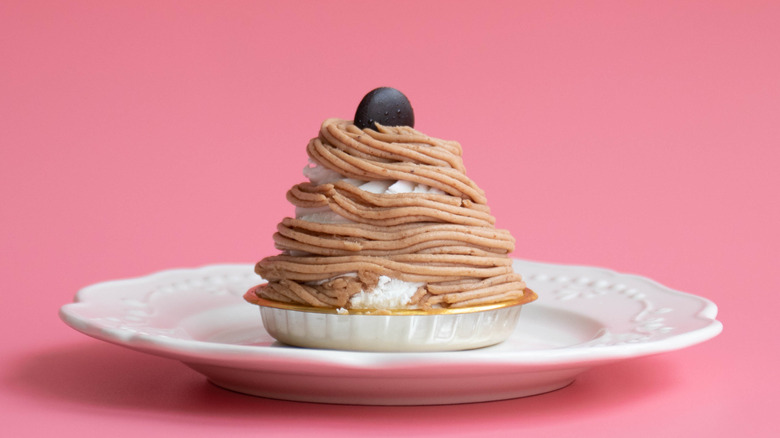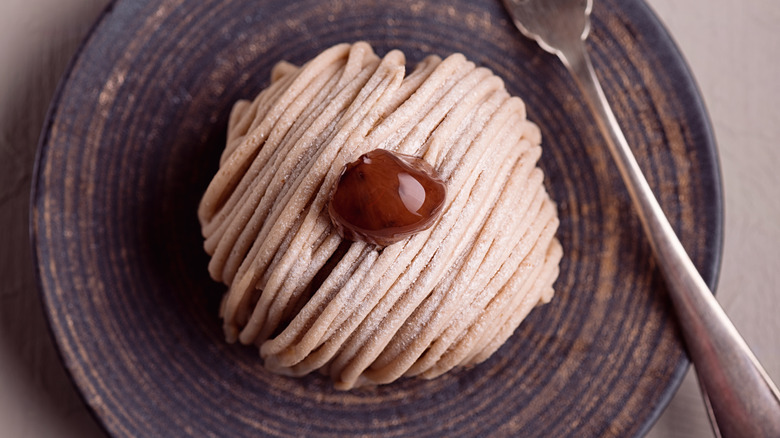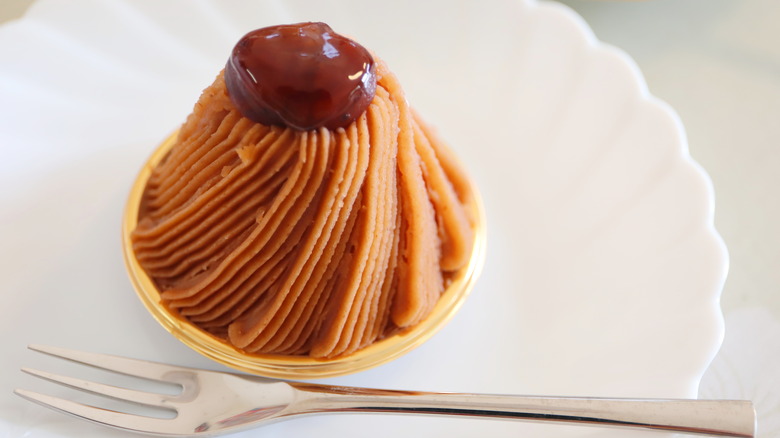What Is A Mont Blanc Dessert?
On the mountainous border between France, Italy, and Switzerland, a majestic peak rises above all others, perpetually snowcapped and razor-sharp on the horizon. Known as Mont Blanc, this mountain has been recognized as the tallest summit in the Alps, offering a tempting climb to seasoned mountaineers and an awe-inspiring sight for the less adventurous. Even if you haven't had the inclination to see the mountain, chances are you can espy a miniature namesake in a French pastry shop.
The Mont Blanc dessert is a Parisian (and Italian) icon, a blend of whipped cream, meringue, and sweetened chestnut pureé piled into a lofty peak meant to resemble the famed mountain. A stark feature is the signature way the chestnut puree is piped into vermicelli strands around the exterior, looking like a threaded nest. The earthy flavor of the chestnuts is complemented by the rich whipped cream, promising a dessert that isn't overly sweet but still luxurious. Over the years, this simple dessert has transformed into a remarkably sophisticated feat of pâtisserie, featuring elaborate meringue bases as well as glistening sugared accouterments. So where does the story of the chestnut Mont Blanc begin? And what modern incarnations can you expect from a pastry chef?
The grand origin of a chestnut classic
Though there are stories that the Mont Blanc dessert may have been served as far back as the 15th century, historical documents point to it being a much more recent invention, popping up by name in records by the late 1800s. The dessert shares distinct DNA with another 19th-century recipe — the compote de marrons en vermicelle, which also shapes the chestnut puree into thin threads. Whatever the origin, the recipe became noticeably popular toward the turn of the century, meriting mention in cookbooks, like Urban Dubois' 1871 French tome "The Household Cookery Book."
Soon, the iteration took on a mythological reputation at the fine Parisian patisserie Angelina. There, the simple chestnut puree and whipped cream formula received a meringue update, incorporating a crisp meringue base to hold the softer elements up. They also used the chestnut threads to cover the whipped cream, removing its faux snow cap for good. Over the years, modern pastry chefs have taken some tasty liberties with the original recipe, incorporating complementary flavors like hazelnut and changing the meringue bottom to a buttery tart or sablé base. As for the peak, you can expect anything from a candied chestnut to a flake of edible gold leaf to act as the crowning focal point.
The many forms of the Mont Blanc dessert
At the same time as the French version of the Mont Blanc began to take shape, an Italian variation known as Monte Bianco arose on the horizon. This take was similar but mixed a bit of dairy, rum, or even cocoa into the chestnut puree to enrich it. Served parfait style in a glass dish, the vermicelli threads of chestnut are often enjoyed with the traditional peak of whipped cream.
The Mont Blanc also inspired a devoted following in Japan. Rumor has it, in the 1930s Japanese pastry chef Chimao Sakota hiked Mont Blanc and brought back the dessert in honor of his accomplishment. True or not, the Mont Blanc dessert has taken on a life of its own in the Japanese isles, adopting a lightly sweet sponge cake base. The dish translated well to their existing repertoire, imitating their mashed sweet potato and chestnut dessert, kanroni. In a further Japanese adaptation, these cakey Mont Blancs are normally topped with candied yellow chestnuts, a classic sweet in Japan.
Wherever you track down a Mont Blanc dessert, you'll be sure to get an appetizing taste of history.



